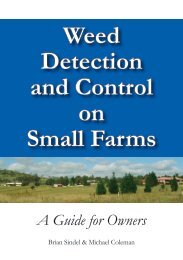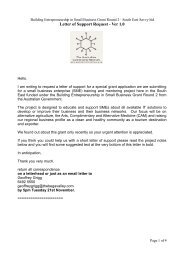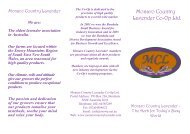Lavender growing for oil production - Platypus Country
Lavender growing for oil production - Platypus Country
Lavender growing for oil production - Platypus Country
Create successful ePaper yourself
Turn your PDF publications into a flip-book with our unique Google optimized e-Paper software.
<strong>Lavender</strong> <strong>growing</strong> <strong>for</strong> <strong>oil</strong> <strong>production</strong><br />
Fred Bienvenu, Ovens Research Station, Myrtle<strong>for</strong>d<br />
September, 1995<br />
AG0450<br />
ISSN 1329-8062<br />
Background<br />
Botany<br />
The lavender genus Lavandula (family Lamiaceae syn.<br />
Labiatæ) has over twenty species that are mostly of<br />
Mediterranean origin. There are three main species within<br />
the genus producing lavender, lavandin and spike lavender<br />
that are essential <strong>oil</strong>s <strong>for</strong> the fragrance and perfume<br />
industry. "True lavender" <strong>oil</strong> is derived from Lavandula<br />
angustifolia (syn. L. officinalis), lavandin <strong>oil</strong> is considered<br />
a hybrid of L. angustifolia × L. latifolia. and finally spike<br />
lavender <strong>oil</strong> is derived from L. latifolia (syn. L. spica).<br />
<strong>Lavender</strong> is the most highly prized of these three <strong>oil</strong>s.<br />
World distribution & <strong>production</strong> areas<br />
<strong>Lavender</strong> is a native of the western Mediterranean and the<br />
eastern coast of Spain, France, Switzerland, North Italy,<br />
Corsica and North Africa. <strong>Lavender</strong> and lavandin <strong>oil</strong> have<br />
long been the major essential <strong>oil</strong>s produced on the<br />
southern slopes of the French Alps. The world <strong>production</strong><br />
of high quality lavender <strong>oil</strong> is about 200 tonnes per year.<br />
Australia's largest farm producing lavender <strong>oil</strong> is the<br />
Bridestowe Estate near Nabowla in the north east of<br />
Tasmania which was established by the Denny family in<br />
1921. The estate currently produces a high quality<br />
lavender <strong>oil</strong> following many years of line selection from L.<br />
angustifolia. Oil produced by this plantation is highly<br />
regarded by the industry. Oil yields at the Bridestowe<br />
Estate have been reported to be normally 50kg/ha but may<br />
be up to 70kg/ha. Recent, annual <strong>production</strong> at this estate<br />
has been approximately two tonnes per year.<br />
Lavandin is native to Spain, France, Italy, and the Balkan<br />
peninsula. Over recent years Bulgaria has become a major<br />
producer. Even more recently the changes in the<br />
economies of countries like Bulgaria and the <strong>for</strong>mer USSR<br />
make the price of lavender and lavandin <strong>oil</strong>s fluctuate<br />
markedly.<br />
The ratio of lavender to lavandin <strong>production</strong> worldwide is<br />
about 1:5 and the prices <strong>for</strong> lavandin is lower. Lavandin<br />
plants produce more <strong>oil</strong> and are more hardy than lavender<br />
plants. The world <strong>production</strong> of lavandin <strong>oil</strong> is about 1000<br />
tonnes per year.<br />
Lavandin <strong>oil</strong>s have been progressively replacing lavender<br />
<strong>oil</strong>s <strong>for</strong> all but the most expensive products. Though<br />
lavender <strong>oil</strong>s bring higher prices, the higher yield of<br />
lavandin make it worthy of consideration. While there is<br />
no shortage of all three of these <strong>oil</strong>s, a stable supply of<br />
high quality lavender <strong>oil</strong> similar to that produced in France<br />
and Tasmania is likely to always have a market.<br />
Spike lavender has its main <strong>production</strong> area in Spain but<br />
grows wild over a large part of the Mediterranean area,<br />
preferring warmer and lower regions than lavender and<br />
lavandin. World wide <strong>production</strong> of spike lavender <strong>oil</strong> is<br />
150-200 tonne per year.<br />
The prices obtained <strong>for</strong> lavender <strong>oil</strong>s vary widely based on<br />
quality and batch size. A broad guide to bulk prices of the<br />
three major groups is:- "True <strong>Lavender</strong>" about $A60/kg,<br />
"Lavandin" about $A15/kg and "Spike <strong>Lavender</strong>" about<br />
$A60/kg (as at Sept.95).<br />
Remember that these prices are <strong>for</strong> large volumes moved<br />
through the established traders. Niche marketing of high<br />
© State of Victoria, Department of Primary Industries Page 1
<strong>Lavender</strong> <strong>growing</strong> <strong>for</strong> <strong>oil</strong> <strong>production</strong><br />
AG0450<br />
quality products in smaller volumes will result in higher<br />
prices being realised. The developing aromatherapy<br />
market is an area that lends itself to such market targeting.<br />
Uses<br />
The <strong>oil</strong>s from lavender, lavandin and spike lavender have<br />
long been used separately and in combination with other<br />
essential <strong>oil</strong>s in the fragrance and perfumery industry.<br />
Minor uses, in terms of quantity, include aromatherapy<br />
which relies on the sedative effects of lavender <strong>oil</strong><br />
vapours. The most likely component to be active in this<br />
regard is linalool.<br />
Production of lavender<br />
The following notes relate to <strong>production</strong> of lavender <strong>oil</strong><br />
under Australian conditions. There is very little data<br />
available on the <strong>production</strong> of lavandin and spike lavender<br />
in Australia.<br />
Cultural requirements<br />
<strong>Lavender</strong> requires free-drainage and less irrigation than<br />
most essential <strong>oil</strong> crops. The plants have a deep rooting<br />
system and are tolerant to both moderate frosts and<br />
drought. Severe frosts will affect the plants. S<strong>oil</strong>s of<br />
neutral (7) pH are preferred but successful crops have been<br />
produced over the range 5.8 to 8.3pH. Nutrition of<br />
lavender crops will normally involve some additional<br />
phosphorus (P) (about 33kg/ha actual P in Tasmania) and<br />
potassium (K), however the actual amounts will vary with<br />
s<strong>oil</strong> types. Nitrogen (N) will need to be supplied in up to<br />
four split dressings throughout the <strong>growing</strong> season and<br />
could total<br />
80-100kg/ha of actual N each year. Care should be taken<br />
to produce the appropriate balance of flowers and leaves.<br />
Experience on a given s<strong>oil</strong> type and geographic region will<br />
be required to get the best <strong>production</strong> of <strong>oil</strong>.<br />
Propagation<br />
Propagation is normally accomplished by taking cuttings<br />
from known genetic sources in winter. Fields are planted<br />
in rows 1-1.2m apart with intra-row spacing of 0.4m at an<br />
approximate density of approximately 20,000 plants/ha.<br />
The first year of the plantation should be <strong>for</strong> establishment.<br />
Harvest in the second year will depend on the rootstock<br />
vigour of a particular stand. The life span of lavender<br />
plants is 10-15 years after which replacement plantings<br />
may be required.<br />
Attention to obtaining the correct genotype is essential as<br />
recognised markets are only open to <strong>oil</strong> that closely<br />
resembles the international standards. Sources of the<br />
preferred genotype are currently not easily available.<br />
Pest and diseases<br />
There are several disease and pest problems that occur in<br />
overseas plantations. Australian plantings have been<br />
relatively free from pests.<br />
An exception found in the Tasmania lavender <strong>oil</strong><br />
producing area is the light brown apple moth Epiphyas<br />
postvittana, a pest of significant proportion (in apple<br />
<strong>growing</strong> areas), which may require some control measures<br />
if found on lavender. Root diseases, Fusarium sp. and<br />
Armillaria sp. have been a problem but selections of<br />
resistant plant types can reduce this problem. The s<strong>oil</strong><br />
nematode, Meloidogyne hapla, has been reported as a<br />
potential threat to lavender <strong>production</strong> in India but has not<br />
yet been a problem in Australia.<br />
Weed control<br />
<strong>Lavender</strong> does not offer good competition <strong>for</strong> weeds,<br />
there<strong>for</strong>e attention to weed control is very important.<br />
Apart from nutrient and water competition between<br />
lavender and weeds, there is considerable risk of<br />
contamination from the weed species in the distilled <strong>oil</strong><br />
product if weeds are allowed to grow in the rows.<br />
Harvest<br />
A dedicated harvester that lifts and clips only the flowering<br />
stems has been developed in Tasmania and would be<br />
needed to efficiently harvest the crop. Over two tonnes of<br />
flower heads per hour is achieved using the Tasmanian<br />
harvester. Yields of 0.8% <strong>oil</strong> from fresh flowers have been<br />
reported.<br />
Typical lavender <strong>oil</strong> yields of 50kg/ha can be expected<br />
from mature plantings. The highest lavender <strong>oil</strong> yield<br />
obtained in Tasmania is reported to be over 70kg/ha.<br />
Harvest commences from mid-December to early-January<br />
depending on seasons in Tasmania.<br />
Extraction<br />
a. Steam distillation<br />
The <strong>oil</strong> is released from the <strong>oil</strong> glands in the flower heads<br />
using steam distillation. Speedy extraction of the <strong>oil</strong> has<br />
some quality benefits. Normal steam distillation<br />
equipment as used in the peppermint and eucalyptus <strong>oil</strong><br />
industries can be used <strong>for</strong> lavender <strong>oil</strong> extraction. Trial<br />
distillations of lavender <strong>oil</strong> have been per<strong>for</strong>med<br />
successfully at the Ovens Research Station from locally<br />
produced lavender crops.<br />
Laboratory-scale distillation units that process 3kg of<br />
flowers at a time are well suited to varietal selection work.<br />
These units can be bought or assembled from readily<br />
available parts <strong>for</strong> a few hundred dollars. Equipment <strong>for</strong><br />
commercial distillation operations would start at a 0.5<br />
tonne distillation plant which could be constructed <strong>for</strong><br />
approximately $10,000 and a fully commercial distillation<br />
unit that would hold up to 8 tonne of flowers could cost<br />
$300,000.<br />
A permit to have distillation facilities is required from the<br />
Licensing Clerk, Australian Custom Service, GPO Box<br />
2809AA, Melbourne, 3001. The permit must be applied<br />
<strong>for</strong> be<strong>for</strong>e constructing distillation equipment.<br />
b. Solvent extraction<br />
A smaller quantity of lavender and lavandin concretes are<br />
produced in Southern France by solvent extractions.<br />
Concretes are extracted from fresh plant material using<br />
solvents such as toluene, hexane and petroleum ether. The<br />
solvents are evaporated off leaving residues called<br />
© State of Victoria, Department of Primary Industries Page 2
<strong>Lavender</strong> <strong>growing</strong> <strong>for</strong> <strong>oil</strong> <strong>production</strong><br />
AG0450<br />
concretes. Concretes find uses in the perfumery industry<br />
(particularly soaps). As in the distilled product the yield of<br />
lavender is less than lavandin using solvent extraction.<br />
A further refinement is to mix concretes with ethanol. The<br />
mixture is then cooled and filtered, then the ethanol is<br />
evaporated to produce a wax-free residue called an<br />
absolute. There is frequently a 50% yield loss from<br />
concrete to absolute. Absolutes are more widely used in<br />
fine perfumery.<br />
Quality<br />
Chemical composition<br />
The main components of the steam distilled products<br />
obtained from gas chromatography are shown in Table.1.<br />
Physical measurements such as density are also required to<br />
fit international standards. As with most essential <strong>oil</strong><br />
products the final test <strong>for</strong> quality will be the organoleptic<br />
(taste or smell) opinion of the flavourists.<br />
Table 1. Major <strong>oil</strong> characteristics found in the three <strong>oil</strong><br />
groups (Expected ranges).<br />
Character <strong>Lavender</strong> Lavandin Spike <strong>Lavender</strong><br />
density 0.876-0.892 0.885-0.897 0.895-0.917<br />
camphor 0.5-1% 4-11% 10-20%<br />
caryophylene 3-12%<br />
cineole 1-2% 5-10% 20-30%<br />
linalool 30-49% 30-40% 40-50%<br />
linalyl acetate 30-45% 20-30%
<strong>Lavender</strong> <strong>growing</strong> <strong>for</strong> <strong>oil</strong> <strong>production</strong><br />
AG0450<br />
Lawrence B.M (1980) New trends in essential <strong>oil</strong>s.<br />
Perfumer and Flavorist 5(4).<br />
Lawrence B.M (1982) Progress in essential <strong>oil</strong>s. Perfumer<br />
and Flavorist 7.<br />
Lawrence B.M (1985) A review of the world <strong>production</strong> of<br />
essential <strong>oil</strong>s - 1984. Perfumer and Flavorist 10(5).<br />
Lawrence B.M (1986) Progress in essential <strong>oil</strong>s. Perfumer<br />
and Flavorist 11(5).<br />
McLeod J.(1994) <strong>Lavender</strong> Sweet <strong>Lavender</strong>,. Kangaroo<br />
Press.<br />
Porter N.G.; Shaw M.L.; Hurndell L.C. (1982) Preliminary<br />
studies of lavender as an essential crop <strong>for</strong> New Zealand.<br />
NZ. J. of Agric Research Vol 25.<br />
This publication may be of assistance to you but the State of Victoria and its officers do not guarantee that the publication is without flaw of any<br />
kind or is wholly appropriate <strong>for</strong> your particular purposes and there<strong>for</strong>e disclaims all liability <strong>for</strong> any error, loss or other consequence which may<br />
arise from you relying on any in<strong>for</strong>mation in this publication.<br />
© State of Victoria, Department of Primary Industries Page 4
















